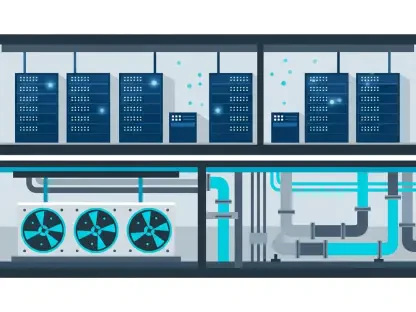As telecom companies across North America and beyond expand their horizons into the fintech sector with offerings like mobile money, digital wallets, and payment processing, they are stepping into a landscape fraught with unprecedented cyber risks that demand urgent attention. The convergence of telecommunications and financial services has created a fertile ground for innovation, but it also exposes these companies to sophisticated threats that can jeopardize sensitive customer data and erode trust. With data breaches capable of inflicting severe financial losses and reputational damage, the stakes have never been higher. This pressing challenge demands a strategic approach to safeguard operations while embracing the opportunities fintech presents. The journey to balance innovation with security is complex, yet essential, as telecoms navigate a regulatory maze and confront evolving cyber threats in an industry not traditionally equipped for such financial intricacies.
Navigating the Cyber Threat Landscape
Understanding the Unique Vulnerabilities
Telecom companies venturing into fintech face a distinct set of cyber vulnerabilities that differ markedly from their traditional operational risks. Unlike conventional financial institutions, these entities often handle vast amounts of personal and transactional data without the benefit of sector-specific regulations tailored to their hybrid business model. This gap leaves them exposed to threats like data breaches and unauthorized access, which can have cascading effects on customer trust and financial stability. The processing of sensitive financial information through telecom networks amplifies the risk, as cybercriminals increasingly target these less fortified entry points. Moreover, the lack of historical experience in managing financial-grade security protocols means that many telecoms are playing catch-up, often underestimating the sophistication of attacks such as phishing or ransomware tailored to exploit fintech integrations. Addressing these vulnerabilities requires a fundamental shift in how telecoms perceive and prioritize cybersecurity within their expanded service offerings.
Adapting to Evolving Threats
The cyber threats targeting telecom fintech operations are not static; they evolve rapidly with advancements in technology, posing a continuous challenge to security frameworks. Sophisticated tactics like AI-driven attacks and social engineering have become more prevalent, exploiting human error and technological gaps with alarming precision. Telecom companies must remain vigilant, recognizing that a single breach can undo years of built trust and incur significant penalties. Staying ahead involves adopting proactive measures such as real-time threat intelligence to anticipate and neutralize risks before they materialize. Additionally, the integration of cutting-edge technologies like machine learning for anomaly detection can bolster defenses against novel attack vectors. Collaboration with cybersecurity experts and learning from the banking sector’s mature practices can further enhance resilience. As threats grow in complexity, telecoms must commit to an adaptive mindset, ensuring their security measures evolve in lockstep with the innovative services they offer to customers.
Building Robust Risk Management Strategies
Implementing Comprehensive Security Controls
To mitigate the cyber risks inherent in fintech ventures, telecom companies must establish comprehensive security controls that address both technological and human factors. Segmenting fintech operations from core telecom services can help isolate risks, ensuring that a breach in one area does not compromise the entire network. Stringent identity and access management protocols are critical to prevent unauthorized access, while regular security audits can uncover vulnerabilities before they are exploited. Employee training also plays a pivotal role, as human error remains a leading cause of breaches; equipping staff with the knowledge to recognize phishing attempts or suspicious activity can significantly reduce exposure. Drawing inspiration from the banking industry, telecoms can adopt best practices like multi-factor authentication and encryption to protect sensitive data. By embedding these controls into their operational framework, telecoms can create a fortified barrier against cyber threats, safeguarding their fintech ambitions without stifling innovation.
Balancing Innovation with Regulatory Compliance
Navigating the regulatory landscape presents another layer of complexity for telecoms in fintech, as they must comply with standards originally designed for traditional financial entities. This often means aligning with stringent banking regulations while lacking clear guidelines specific to their hybrid operations, creating ambiguity that can heighten risk. Risk managers need to work closely with legal and financial teams to interpret and apply these rules effectively, ensuring compliance without hampering service delivery. Proactive engagement with regulators can also help shape future policies that better accommodate telecom fintech models. Meanwhile, maintaining a balance between innovation and compliance requires continuous monitoring of both technological advancements and regulatory updates. Leveraging existing infrastructure, such as edge computing, can enhance service efficiency while meeting security standards. Ultimately, telecoms that master this balance will not only mitigate risks but also position themselves as trusted players in the competitive fintech space.
Preparing for Future Challenges
Looking ahead, telecom companies must anticipate that the complexity of cyber risks will intensify as fintech services expand and new technologies emerge. Staying informed about developments like quantum computing or advanced AI threats is essential to preempt potential vulnerabilities. Investing in innovative security solutions, such as predictive analytics, can provide an edge in identifying risks before they escalate. Furthermore, fostering a culture of continuous improvement ensures that security protocols remain relevant amid rapid change. Collaboration across departments and with industry peers can yield insights into emerging best practices, turning challenges into opportunities for differentiation. By preparing for future threats with strategic foresight, telecoms can transform potential weaknesses into competitive strengths, securing their foothold in the financial services sector. Reflecting on past efforts, it became evident that those who prioritized adaptability and proactive planning were better equipped to handle the unforeseen, setting a precedent for sustained success in this dynamic field.









